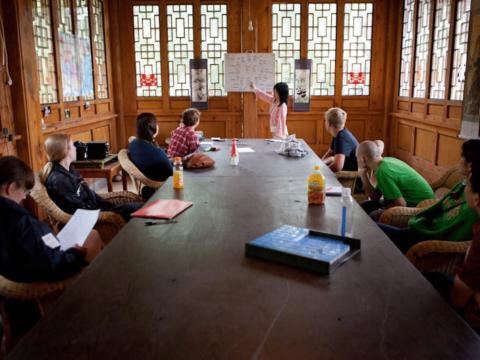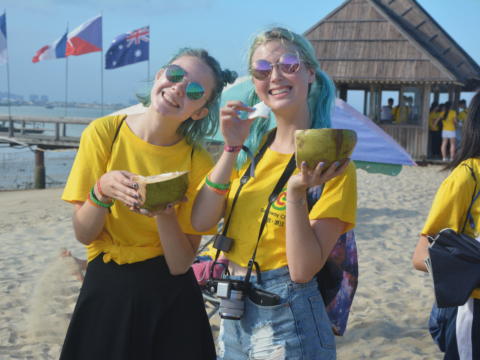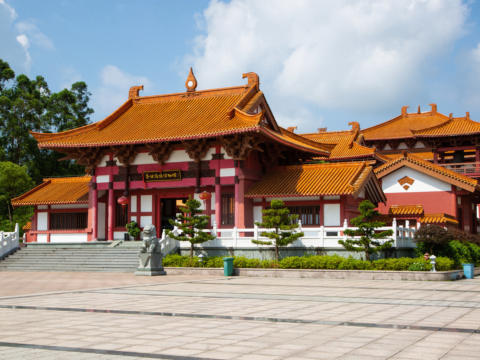Only 225€ per week!
Culture Week
Guilin - China
Come face to face with China and say ni hao! This introductory week is the first step towards a great experience in a new country.
It is designed so that you can begin to understand the Chinese ways of doing things. It is a fun filled week that is dedicated to getting to know China and some of its cultural aspects first hand. You will also get time to meet the local people, bond with fellow participants, taste the local cuisine and become familiar with the Chinese customs.
Program Description
Given its objective – learning about traditional, rural Chinese culture, it is appropriate that this week takes place in Guilin’s rural Fengyan village. There are many opportunities to immerse yourself in the culture with visits to local villages, a Confucius temple and a Guan Gong temple, local fairs and some amazing natural scenery sites.
Whilst it has the longest written history in the world, and despite its staggering economic performance and entry onto the world stage, as heralded by the Beijing Olympics, China remains an enigma to many.
Of all Asian countries, it is perhaps the least understood. This program takes you beyond the headlines that appear in the Western press, away from politics, away from the big cities and the normal tourist attractions.
It takes you into the traditional lives of the rural communities. It helps you to understand their culture and everyday activities. It takes you beyond hearing about the issues of ‘face’ and ‘guanxi’ to a real understanding of what they mean. You will visit an old traditional house – but also understand its deep significance within the land reforms.
You will go to the Confucius temple, not just to look, but to understand what it meant and how it felt to be the number one scholar in the Emperor’s examinations and you will experience the route through the temple that only he could travel.
You will learn how to make dumplings, taste oil tea, and learn the rudiments of the language, practice calligraphy, as well as some of the rituals. Through a range of activities: learning sessions, visits, sightseeing and hands-on practical cooking/craft sessions, you will gain a deeper appreciation for what China gave, and continues to give, to the world.
But we also focus on developing a practical understanding of everyday China, beyond its cultural roots. It is the ideal start point for anyone visiting China.
It is a programme developed and delivered by Chinese people after careful research into what westerners really want to know. You will be with both Chinese and Westerners; discussing cultural differences not in an academic sense but in reality.
There is only one rule: if you want to know anything – ask!
Aims & Objectives
- Give you a real insight into authentic Chinese culture
- Get you to feel comfortable in your new surroundings
- Help you learn phrases and understand the culture you will be engaging with
Schedule
Monday
Your day begins with a a tour of Fengyan village and its ancient house. Fengyan, a Yao People village with more than 400 hundred-years history and has some houses with 150+ years, traditional Yao’s house. After that you will go to climb a mountain in the village where you can see sea of persimmon trees.In the afternoon you will have a Chinese language lesson and a session about Chinese philosophies on life and local taboos. During the evening you can learn how to play Mahjong, Chinese chess or watch a Chinese movie.
Tuesday
In the morning you will visit a local family and learn how to make oil tea, which is called Chinese coffee, then enjoy a traditional breakfast of Yao people. A Taichi lesson starts your day,After that you’ll take part in a culture session focusing on Chinese festivals. Then there is a visit to Hongyan village during the late afternoon, we will climb mountains and do some bamboo rafting in the village. During the evening you can learn how to play Mahjong, Chinese chess or watch a Chinese movie.
Wednesday
Here we dive into Chinese lesson,where you will learn how to buy and bargain in Chinese right after breakfast, then we will go to Lianhua town. While there, you will explore the town and do some shopping in local market with the Chinese you just learned! A Chinese food culture session is due after lunch where we will discuss the diversity of Chinese food. After that you will try to make dumplings or Baozi, and learn how to cook some Chinese food.
Thursday
We begin with a Chinese songs lesson in the morning, followed by a Chinese Calligraphy lesson.,In the afternoon we will take our learning outside as we visit the Confucius and Guangdong temples and walk along the Cha river. Also, you will visit Gongcheng YAO People’s Musuem and learng the history,culture, folk of it. After the visiting you will have free time and can go to supermarket for shopping. During the evening you can have a self-organized BBQ in the center.
Friday
After your another Chinese language lesson we’ll take part in some Chinese paper crafting! Today’s afternoon is quite free, for you to relax, or to prepare for any weekend excursions you may like to take part in!
Note: This schedule can be changed and/or amended depending on weather conditions, local conditions and unforeseen circumstances.
Participant Criteria & Requirements
Standard Requirements
Minimum age: –
Maximum age: –
Minimum English level: Basic
CRB required: On Signup
Passport copy required: No
Resume copy required: No
Required qualification: None
Additional Requirements
There are no specific requirements for this program.
Additional Equipment
- Good shoes for the mountain walks
Location
Guilin is a province in southern China known for its dramatic landscape of limestone karst. In the majestic shadow of its mountains, on the edge of an authentic, rustic village lies our center – a 260 year old building from the Qing dynasty. Its surroundings invite walking and hiking and offer a stunning view of the hills, as well as of locals farmers hard at work!
About the Accommodation
This accommodation has western style toilets, a bar with a variety of drinks, snacks, and food all set in a unique Chinese atmosphere.
Food Arrangements
We have our in-house chef busy making food everyday for you! Expect typical Chinese food with rice and noodles in Chinese dishes styles. Vegetarian food is also available upon request.
Facilities
Support
We have fully trained Chinese coordinators at our centre. They are bilingual (Chinese – including local dialect, and English). They too live as part of the family at the Centre and are there to run scheduled activities whilst also assisting those who want explore the area or undertake self-organised activities. They are there 24/7 to deal with any problems participants may have.
Shops
There is a small local shop which sells snacks on site, but to reach ATMs and bigger shops, it is a 30 minute bus journey into town.
Transportation
Our Centre is about 4 kilometres away from Lian Hua town. It is easy to catch a bus into town during the day – or to cycle. Gongcheng is the largest town nearby and is about 20 kilometers away. Once again there are frequent buses or shared taxis. Frequent buses also go from there to Yangshuo, 42 kilometres away.
Money
There are days where you will not have many opportunities to spend your money but food, drinks and snacks can all be purchased cheaply. Around 100 Yuan a week should be more than enough. You will however need much more if you are looking at ‘extras’, such as self-organised trips during the week (e.g. to the street barbecues in Gongcheng). Take note that the nearest ATM that accepts international bank or credit cards is half an hour away by car so if you have such plans, you should get cash out at the airport upon your arrival, or in Yangshuo while you are there.
Activities & Events
No scheduled activities outside the program.
Sights & Surroundings
There are so many wonderful sights and places to visit in this area. A guide book can tell you everything you could want to know, but here are a few ideas we recommend:
The Li River
This river spans 80km from Guilin to Yangshuo and is decorated with rolling hills, unique cliffs, caves and comfortable boats and should not be missed. Especially popular among Chinese tourists is a spot close to Yangshuo that is portrayed on the 20 Yuan bill.
Yangshuo
A picturesque city famous for its surrounding hills, rivers and bar streets. Lots of activities offered including rafting, biking, rock climbing, a stunning light show on Li River and much more. Make sure to spend at least one of your weekends here.
Seven Star Park
Famed for its rock formations, the park includes many different attractions including the Flower Bridge, Seven-Star Cave, Camel Hill and even a zoo!
Transportation
From this location we do not provide free transport to other locations.
Quick Facts
Name: People’s Republic of China
Population: 1.37 billion
Capital: Beijing
Language: Standard Chinese
Currency: Renminbi (Yuan) (CNY)
Time zone: CST (UTC +8)
Country Information
China covers approximately 9.6 million square kilometers making it the 2nd largest country by land area. It is not only the country with the largest population in the world but it is also one of the largest economies laying claim to being the world’s largest exporter and 2nd largest importer of goods.
It is a country of incredible cultural history boasting one of the earliest ancient civilisations dating back to around 2800 BC. Its landscape is equally rich in diversity, ranging from its forest steppes, its deserts in the north and subtropical forests in the south to its 14,500km long stretch of Pacific Ocean coastline. All of this makes China an incredible and exciting place to be, both in what it has to offer today and the story of its past.
Climate
Due to the vast expanse of land that China covers both in terms of longitude and latitude, the climate varies greatly from place to place. Generally, the climate pattern in China is characterised by dry seasons and wet monsoons. The rainy seasons mainly span from May to september but this pattern is less consistent in the some areas such as the dry northwest.
The difference in season causes a pronounced disparity in temperatures between winter and summer. Whilst the summer offers warm temperatures almost everywhere, the winter can cause temperatures to drop significantly, especially in the northern areas of China.
The Monsoon
The southern provinces start to experience the monsoons first, starting in April and May. The winds start to blow north in June meaning that northern provinces receive the rains around July and August, and the rains start to come to an end in September and are generally completely over in October. The northwest of China is the only area that avoids the monsoon climate.
Culture
China is one of four great ancient civilizations with 3,600 years of written history, and its culture both past and present is incredibly profound. Whilst Chinese cultural identity has many common, unifying elements, it is a country that represents 56 ethnic minority groups, the largest of which is the Han Chinese (900 million people), with other groups including the Tibetans, Mongols, Naxi etc. The significance of this is that each group to an extent creates their own culture and so within the vast expanse of China, depending on where you are, cultural variety is plentiful and there to be explored!
The country is currently ruled by The Chinese Communist Party. It is officially atheist, but is slowly and surely becoming more tolerant towards the practice of religion. The five official religions in China are Buddhism, Taoism, Islam, Catholicism and Protestantism. Due to the fact that it is only in recent years that tolerance of religion has made any progress, the practice of other religions is not formally recognised, although are often tolerated especially in the case of ancient Chinese beliefs. Currently about a quarter of the population practice Taoism, Confucianism and other traditional religions.
Gastronomy
There are 8 different styles of traditional Chinese cuisine, and traditional food can be found everywhere in China. Other styles adopted into Chinese cuisine and that might be found in China include Singaporean, Malaysian, Indonesian, Indian and American cuisine.
The staple foods used in Chinese cooking include exactly what you would expect: rice, noodles, and vegetables with sauces and seasonings.
The attitude regarding food in China is generally “waste not, want not” meaning that it not just uses a wide variety of both plants and animals, but every part of these plants and animals are used in some way. For westerners this might mean that there are a few things on the menu that you may not be used to and might want to avoid.
Due to the scale of the country, it isn't surprising that each area of China has a unique style of cooking and the ingredients very much depend on the natural agricultural produce of the specific region. For example the south of China uses far more rice than the north, where wheat is its main ingredient, a reason why noodles and dumplings are much more common. Southern food is also typically more spicy than that of the north.
Common Chinese dishes include: Sweet and Sour Pork, Gong Bao Chicken, Ma Po Tofu, Wontons, Dumplings, Chow Mein, Peking Roasted Duck and Spring Rolls
Transportation
Like its economy, China’s transportation network has rapidly expanded over recent years and now houses the longest road network in the world as well as the busiest train network
Air
Although the most expensive means of transportation, it is by far the most convenient and can save a lot of time travelling the longer distances across China.
The main ports of air travel are Beijing, Shanghai, Guangzhou and Hong Kong although all major cities within the country host domestic flights.
Rail
This is the primary mode of transportation in China and most major cities have their own metro systems. As well as its standard vast rail network, China boasts over 7000 km of high-speed rail.
Bus
For local travel, buses are a very affordable way of getting around and a good alternative mode of transport where metro is not available.
Taxi
Taxis are generally cheap and easy to find. Meters are generally used in towns and cities. If your driver does not want to use a meter, common for longer trips out of town, be sure to negotiate a price before the journey.
Other Alternatives
Motor pedicabs, pedicabs and motorbikes can all be found in China and are a cheap way of getting around. We recommend you set a price before using this form of transport.





